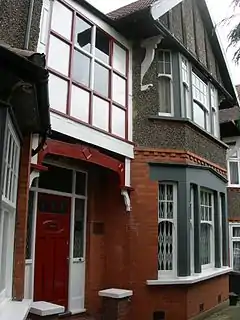Francis Skaryna Belarusian Library and Museum
Francis Skaryna Belarusian Library and Museum in London, England, is the only library outside Belarus to collect exclusively in the field of Belarusian studies and its collection is the most comprehensive in this field in Western Europe. The library is an independent institution owned by a charitable trust. It is located at 37 Holden Road, North Finchley, London. The library is named after Francysk Skaryna, a Belarusian and East-Slavonic publishing pioneer.
 | |
| Established | 15 April 1971 |
|---|---|
| Location | North Finchley |
| Access and use | |
| Circulation | Library does not publicly circulate |
| Population served | researchers, Belarusian community and anyone interested in Belarus |
| Other information | |
| Director | governed by the Board of Trustees |
| Staff | supported by volunteers |
| Website | |
| Map | |

| |
Collections
Currently, the book collection is estimated to contain over 30,000 volumes, among them over 20 printed before 1800. The strongest areas of the collection are history, literature, language, religion, folklore, local lore, bibliography, music and art. All standard reference works are available. A collection of expatriate publications, both books and periodicals, is fairly comprehensive. New publications from Belarus are being purchased regularly, as well as all important Belarus-related works appearing abroad in any language. Most of books are in Belarusian language, a fair number in Russian and Polish, fewer in German, French and other languages. The library receives over 40 current periodicals from Belarus and abroad. The serials collection has over 200 titles; some of them are rare pre-1939 publications. The cartographic collection consists of over 100 maps from the sixteenth century onwards. The collection of Belarusian music records on LPs is comprehensive; more recent records on cassettes and CDs are collected episodically, with the emphasis on folk, rock and classical music. The archive is extensive; it is the least studied area of the library collection. It contains Church documents of the 18 and 19th centuries, materials dating from the period of the Belarusian Democratic Republic (1918), archives of Belarusian organisations and personalities in exile.[1]
History
The history of the Library collection began with the establishment of the Belarusian Catholic Mission in London in 1947 and its move to Marian House on Holden Avenue in the following year. There, a small (two to three hundred) but valuable collection of Belarusian books brought to England by Fr Česlaus Sipovič was housed in the southward-facing room on the first floor, immediately above the Mission's chapel. The Library served as a study centre and meeting place for the student associations Žyćcio and Ruń, and was used by a number of scholars interested in Belarusian heritage.[2]
In the following decade, the book collection increased tenfold and by 1957 was supplemented by subscriptions to all the main periodicals appearing in the BSSR and Belarusian diaspora. In 1958 it received a name Bibliotheca Alboruthena. In the same year, Fr Leo Garoshka moved from Paris to join the Belarusian Catholic community in London. He brought with him an excellent private library, which included a number of rare books published in western Belarus before the Second World War. This collection was added to the Bibliotheca Alboruthena making it the largest Belarusian library in western Europe. Frequently, the library was receiving further collections and items from visitors and Belarusians around the world. When in 1960 Fr Česlaus Sipovič was appointed Bishop and Apostolic Visitor of Belarusians in 1960, he was succeeded by Fr Leo Garoshka as the Bibliotheca Alboruthena's librarian. In the 1960s, there was made the first attempt to catalogue the collection.[3]
In 1968 the book collection was over 6,500 volumes and growing on the account of developing interest to the Belarusian Studies in British universities. In these circumstances it was decided to purchase a whole building to house the library collection (except the religious books not relevant to the Belarusian studies[4]), its archive, as well as the small museum housed, since 1967, in the adjusted building of the St Cyril's Belarusian school.[3]
The library was formally opened on 15 May 1971. Before that, in January 1971, Fr Alexander Nadson assumed the role of librarian instead of Fr Leo Garoshka appointed Director of the Belarusian service of the Vatican Radio. Initially the library was directed by a Board of Governors.[5] In 1979, the Library was registered as a Charitable Trust governed by a Board of Trustees appointed from among members of the Belarusian Catholic (Fr Alexander Nadson, Fr Felix Žurnia) and Orthodox (Fr J. Piekarski) clergy, representatives of the Belarusian community in Britain (P. Asipovich, J. Dominik, J. Michaluk) and British scholars with a special interest in Belarusian studies (Jim Dingley, Arnold McMillin, Guy Picarda). Bishop Česlaus Sipovič remained its Chair until his death in 1981; he was succeeded by Fr Alexander Nadson. Peter Mayo was appointed a Trustee to succeed Fr Žurnia who died in 1982.[6]
The institution was conceived as a reference library for supporting Belarus-related research; its chief aim was defined as "to collect all material, both in printed and manuscript forms, relating to Byelorussia, and to make it accessible to all those interested in any aspect of Byelorussian studies".[6] By 1991, it acquired over 12,000 titles with an annual increase of 300-400. It was receiving practically all Belarusian publications, as well as those relating to Belarus, which appeared in BSSR, Poland and the West. In 1990, the Library established an exchange agreement with the Belarusian Academy of Sciences Library, Minsk, which allowed it to receive duplicate copies of publications of the 1920s and 1930s - otherwise unobtainable - in exchange for expensive scholar publications from the West.[6] Its holdings were also enriched considerably by systematic search for old and out-of-print publications and by numerous gifts and bequests from various benefactors. Most books were in Belarusian, but with a considerable number of works in other languages, in particular Polish and Russian. An extensive collection of microfilms and microfiche was also acquired.[7] For the large part of the 1990s and 2000s, Prof Adam Maldzis (Minsk) singlehandedly supplied the Library with books and periodicals appearing in Belarus.[8] This was the period of booming publishing in Belarus; eventually, it became impossible to collect all Belarus-related publications appearing worldwide.
The library has organised several international seminars and conferences in Belarusian studies.[9] [10]
As the health of Fr Alexander Nadson, the long-standing head of the Board of Trustees and primary keeper of the institution, started deteriorating, the Francis Skaryna Belarusian Library and Museum entered the period of decline.[8] It was removed from the list of charitable organisations in 2011 for the lack of activities.[11] In 2014, the Board of Trustees reconvened to revive the institution and ensure its future.[12] The Mission Statement[13] and Aims[14] were adopted revising, for the first time since 1971, the initial aims of the institution: in addition to collecting and preservation of the Belarusian cultural heritage, and supporting the Belarusian studies - to contribute to the life of the Belarusian community in Britain and encourage interest in Belarus among the British public. In 2015, as a confirmation of its revival and important place in the life of the British society, the institution received a new charity registration.[15]
Since then, it began a programme of digitisation of its most valuable and rare items, series of events and collaborative working with other institutions in Belarus and other countries.[16]
In late 2016, the Church of St Cyril of Turau and All the Patron Saints of the Belarusian People has been built next to the Francis Skaryna Library.
See also
References
- Ivanoŭ, Ihar (2006). Baltic and Slavonic libraries in Britain: their place in developing group identity and the life of émigré communities. London: Manifold. p. 82. ISBN 0901067156.
- The Francis Skaryna Byelorussian Library and Museum (Anglo-Byelorussian Historical papers no.1). London: Anglo-Byelorussian Society. 1971. p. 4.
- The Francis Skaryna Byelorussian Library and Museum (Anglo-Byelorussian Historical papers no.1). London: Anglo-Byelorussian Society. 1971. p. 5.
- Dingley, Jim (1991). The Francis Skaryna Byelorussian Library and Museum. London. p. 1.
- The Francis Skaryna Byelorussian Library and Museum (Anglo-Byelorussian Historical papers no.1). London: Anglo-Byelorussian Society. 1971. p. 6.
- Dingley, Jim (1991). The Francis Skaryna Byelorussian Library and Museum. London. p. 2.
- Dingley, Jim (1991). The Francis Skaryna Byelorussian Library and Museum. London. p. 3.
- Ivanou, Ihar (2015). "Belarusians in the UK: library as a soft-power tool". Belarusian Review. 27 (3). Retrieved 13 April 2016.
- Гардзіенка, Наталля (2010). Беларусы ў Вялікабрытаніі. Мінск: Медысонт. pp. 438–441. ISBN 978-985-6887-63-8. Retrieved 8 September 2015.
- Nadson, Alexander. "Guide to the Library". Francis Skaryna Belarusian Library and Museum. Retrieved 8 September 2015.
- "278442 - The Francis Skaryna Belarusian Library and Museum". Charity Commission. 2016. Retrieved 15 April 2016.
- Шупа, Сяргей (6 May 2015). "Пасьля Надсана". Радыё Свабода. Retrieved 15 April 2016.
- "Mission Statement". Francis Skaryna Belarusian Library and Museum. 26 July 2015. Retrieved 15 April 2016.
- "Aims". Francis Skaryna Belarusian Library and Museum. 26 June 2015. Retrieved 15 April 2016.
- "1161434 - THE FRANCIS SKARYNA BELARUSIAN LIBRARY AND MUSEUM". Charity Commission. 2016. Retrieved 15 April 2016.
- "Trustees' Annual Report for 2015". Francis Skaryna Belarusian Library and Museum. 7 March 2016. Retrieved 15 April 2016.